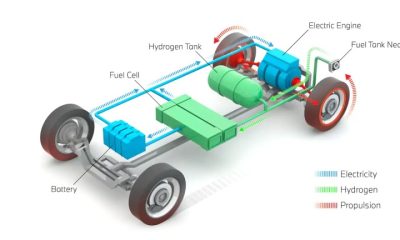Industries
Industry 4.0; meaning, Technologies and concept

Industry 4.0 is a term often used to refer to the developmental process in the management of manufacturing and chain production. The term also refers to the fourth industrial revolution. Industry 4.0 appeared at the first at the famous Hannover Fair in 2011. It was a project strategy of the German Industry. The term was later adopted in the year 2015 World Economic Forum (WEF) in Davos, Switzerland and also appeared in “The Fourth Industrial Revolution,” by Klaus Schwab, who is the founder and president of WEF.
Industry 4.0 is the fourth generation automation practice in traditional manufacturing and industrial practices, using modern technology of the Cyber-Physical systems and internet of things. Industry 4.0 is defined as the integration of information and communications technologies with industrial technology combining Cyber-Physical Systems linked in the supply chain and manufacturing processes with usage of the Internet of Things and Industrial developments.
Looking at comparable ideas from a global perspective, similar idea is promoted under the name of cyber physical systems, smart factory, smart production, machine-to-machine, advanced manufacturing, internet of everything or industrial internet .
Industry 4.0 or fourth industrial revolution also refers to next phase in digitalization of things looks to play a huge role that have the potential to feed information into it and add value to manufacturing industry to realize a low-volume, high-mix production in a cost-efficient way. It also involves the management and organization of the entire value chain process of the manufacturing industry.
Various organization have been advocating industrial internet of things and industry 4.0 concepts to create smarter factories. Meanwhile according to the idea of industry 4.0 includes a wide variety of devices, from smart phones, gadgets, televisions and watches to household appliances which are becoming more flexible and intelligent.
History of Industrial Revolution
The term Industry 4.0 was first publicly introduced in 2011 as “Industry 4.0” by a group of representatives from different fields (such as business, politics, and academia) under an initiative to enhance the German competitiveness in the manufacturing industry. The German federal government adopted the idea in its High-Tech Strategy for 2020. Subsequently, a Working Group was formed to further advice on the implementation of Industry 4.0.
In 2013, they developed and published their first set of recommendations. Their vision entailed that
“These Cyber-Physical Systems comprise smart machines, storage systems and production facilities capable of autonomously exchanging information, triggering actions and controlling each other independently. This facilitates fundamental improvements to the industrial processes involved in manufacturing, engineering, material usage and supply chain and life cycle management.”
On the 10 October 2016, the Forum announced the opening of its Centre for the Fourth Industrial Revolution in San Francisco. This was also subject and title of Schwab’s 2016 book. Schwab includes in this fourth era technologies that combine hardware, software, and biology (cyber-physical systems), and emphasizes advances in communication and connectivity.
This era is expected to be marked by breakthroughs in emerging technologies in fields such as robotics, artificial intelligence, nanotechnology, quantum computing, biotechnology, the internet of things, the industrial internet of things, decentralized consensus, fifth-generation wireless technologies, 3D printing, and fully autonomous vehicles.
To be able to understand how Industry 4.0 became today’s buzzword; a look at its predecessors might give us a perspective on how this revolution in particular is different. The following diagram shows a timeline of the evolution of manufacturing and the industrial sector in general

Industrial manufacturing evolution to Industry 4.0
The First Industrial Revolution
The industrial revolution in Britain came in to introduce machines into production by the end of the 18th century (1760-1840). This included going from manual production to the use of steam-powered engines and water as a source of power.
This helped agriculture greatly and the term “factory” became a little popular. One of the industries that benefited a lot from such changes is the textile industry, and was the first to adopt such methods. It also constituted a huge part of the British economy at the time
The Second Industrial Revolution
The Second Industrial Revolution, also known as the Technological Revolution, is the period between 1871 and 1914 that resulted from installations of extensive railroad and telegraph networks, which allowed for faster transfer of people and ideas, as well as electricity. Increasing electrification allowed for factories to develop the modern production line. It was a period of great economic growth, with an increase in productivity, which also caused a surge in unemployment since many factory workers were replaced by machines.
However, such revolutionary approaches to industry were put to an end with the start of World War I. Mass production of course was not put to an end, but only developments within the same context were made and none of which can be called industrial revolutions.
The Third Industrial Revolution
Perhaps the third one is much more familiar to us than the rest as most people living today are familiar with industries leaning on digital technologies in production. However, the third industrial revolution is dated between 1950 and 1970.
The Third Industrial Revolution, also known as the Digital Revolution, occurred after the end of the two world wars, resulting from a slowdown of industrialization and technological advancement compared to previous periods. The production of the Z1 computer, which used binary floating-point numbers and Boolean logic, a decade later, was the beginning of more advanced digital developments.
Others call it the Information Age too. The third revolution was, and still is, a direct result of the huge development in computers and information and communication technology.
The Fourth Industrial Revolution
The Fourth Industrial Revolution marks the beginning of the Imagination Age towards automation which will depend on data acquisition and sharing along the entire supply chain. At the same time, Industry 4.0 is a new method to connect the digital world with the physical world. Industry 4.0 can be described as the manufacturing environment’s increased digitization and automation in addition to an increased communication enabled by the creation of a digital value chain.
The term of Industry 4.0 is an “umbrella term for a new industrial paradigm” and it consist of Cyber-Physical System (CPS), Internet of Things (IoT), Internet of Services (IoS), Robotics, Big Data, Cloud Manufacturing and Augmented Reality.
In the following two parts, the key technologies of Industry 4.0, as well as challenges of adopting Industry 4.0, will be introduced as a theoretical basis.
Industry 4.0 Key Technologies and Trends
The concept of Industry 4.0 however, is not a simple one. It envelops many technologies and is used in a variety of different contexts. There are five pieces that define Industry 4.0 at its core. Each piece is similar in nature but, when integrated together, create capability that has never before been possible. The evolution of the web has great contribution to development of Industry 4.0. In an effort to understand Industry 4.0, the following five trends are explained as they contribute to the next industrial revolution:
- Cyber Physical System
- Internet of Things
- Smart Factory
- Big Data
- Cloud computing
Cyber Physical Systems
Cyber physical systems are integrations of computation, networking and physical processes. Computers and networks monitor and control physical processes with feedback loops; the physical system reacts; the system uses software to interpret actions and tracks results. The notion centers on computers and software being embedded in devices where the first use is not computation; rather it is a loop of action and machine learning.
Internet of Things (Iot)
The internet of things is a simple term for a grandiose concept. IoT is the connection of all devices to the internet and each other. As Wired said, “it’s built on cloud computing and networks of data-gather sensors; it’s mobile, virtual, and instantaneous connection.” This interconnection will enable “smart factories” to take shape as equipment will use data to manufacture, move, and report and learn at astounding rates, efficiently.
Adoption of IoT can offer new opportunities to users, manufacturers and companies in industrial environments and whole supply chains. It has a strong influence in different fields such as automation, industrial manufacturing, logistics, business processes, process management and transportation. Furthermore, there is a new term called Industrial Internet of Things (IIoT) which means the application of IoT in industry. To improve modern industrial systems, IIoT applies disruptive technology such as sensors, actuators, RFIDS, software, control-systems, machine-to-machine, data analytics and security mechanisms. Nowadays, IoT emerges within three major fields which include process optimization, optimized resource consumption and creation of complex autonomous systems.
Smart Factory
Smart Factory is the concept of a production environment in which production facilities and logistics systems are organized without human intervention.
The Smart Factory is no longer a vision. While different model factories represent the feasible, many enterprises already clarify with examples practically, how the Smart Factory functions. The technical foundations on which the Smart Factory – the intelligent factory – is based are cyber-physical systems that communicate with each other using the Internet of Things and Services.
An important part of this process is the exchange of data between the product and the production line. This enables a much more efficient connection of the Supply Chain and better organization within any production environment.

A brief framework of the Smart Factory of Industry 4.0
The Fourth Industrial Revolution fosters what has been called a “smart factory”. Within modular structured smart factories, cyber-physical systems monitor physical processes, create a virtual copy of the physical world and make decentralized decisions. Over the internet of things, cyber-physical systems communicate and cooperate with each other and with humans in synchronic time both internally and across organizational services offered and used by participants of the value chain.
Figure below illustrates a Smart Factory framework that includes four tangible layers: physical resource layer, industrial network layer, cloud layer and supervision as well as control terminal layer. The physical resources are smart things and can be used for communication through industrial networks. The cloud layer can be applied in several information systems such as ERP to collect massive data based on the physical resource layer, and then, exchange the data with people by the terminals.
Big Data
Big Data is a collection of data from traditional and digital sources inside and outside your company that represents a source for ongoing discovery and analysis. Today data is collected everywhere, from systems and sensors to mobile devices. The challenge is that the industry is still in the process of developing methods to best interpret data. It’s the evolution of Industry 4.0 that will change the way organizations and solutions within those organizations work together; teams will be able to make better, smarter decisions.
Roadmap of Industry 4.0
There are 4 different maturation stages in Industry 4.0 adoption in organizations. They are:
Digital Beginner: Industrial companies are beginners on the path of industrial 4.0. At this level the initial digitization results are attained in all divisions as well as in discrete products and service portfolios. Compliance is not guaranteed in this stage and digital hazards are not documented.
Vertical Integrator: Is the second maturity stage of companies in Industry 4.0. Companies use integrated software also known as embedded systems and it allows internet based transmission of the product with the manufacturing mediums. The network existence provides market arrival by explicit online sites and product inventory.
Horizontal Collaborator: Is the third maturity stage that integrates the value chain with customers and stakeholders. It integrates customers, suppliers and subcontractors along the production line. It is better coordinated with logistics service providers and hence creates proficiency with increase in quality, enhance the time for handling the process or shrink operating costs. Compliance is maintained throughout all the functions of the business and digital hazards are administered with improved methods.
Digital Expert: It is connected to its operative and executive processes worldwide and will virtualize these processes. The crucial executive procedures are globally improved according to the costs and control specification. The expansion of internet solutions for industries needs a large investment. One can follow many ways to achieve the title of digital champion. It should be based on its configuration of the existing product and service as well as on the operative and executive processes and capacity.
Industry 4.0 in Manufacturing
Manufacturing is entering the fourth industrial revolution. Digitalization – powered by the use of sensors, software, connectivity and big data analytics – is resulting in leaner and more efficient factories and driving the introduction of flexible new business models. It’s been quite the journey to get to where we are today.
Companies like Tesla uses industry 4.0 concept in mass production and distribution of their vehicles like the Tesla Model 3
Challenges in implementation of Industry 4.0
Economic challenges include; High economic costs, Business model adaptation and Unclear economic benefits/excessive investment.
Social challenges include; Privacy concerns, Surveillance and distrust, General reluctance to change by stakeholders, Threat of redundancy of the corporate IT department, Loss of many jobs to automatic processes and IT-controlled processes, especially for blue collar workers, increased risk of gender inequalities in professions with job roles most susceptible to replacement with AI.
Political challenges include; Lack of regulation, standards and forms of certifications and Challenges Unclear legal issues and data security.
Organizational challenges include; IT security issues, which are greatly aggravated by the inherent need to open up previously closed production shops. Reliability and stability needed for critical machine-to-machine communication (M2M), including very short and stable latency times. Need to maintain the integrity of production processes, Need to avoid any IT snags, as those would cause expensive production outages, Need to protect industrial know-how (contained also in the control files for the industrial automation gear) Lack of adequate skill-sets to expedite the transition towards a fourth industrial revolution. Low top management commitment and insufficient qualification of employees.
Criticism
With the consistent development on automation of everyday tasks, some saw the benefit in the exact opposite of automation where self-made products are valued more than those that involved automation.

-

 Brands2 years ago
Brands2 years agoRevBio Tetranite Regenerative Bone Adhesive Actions and Microgravity Technology.
-

 Brands2 years ago
Brands2 years agoBMW ix5 Hydrogen; Features, Release date, Price and specs.
-

 Brands2 years ago
Brands2 years agoBMW i7 All Electric Executive Sedan Features and Price
-

 Lifestyle2 years ago
Lifestyle2 years agoJeff Bezos; Networth, Career and lifestyle
-

 Brands2 years ago
Brands2 years agoDodge Charger Daytona SRT EV Concept; Electric muscle car specs, release date and price
-

 Brands2 years ago
Brands2 years agoHydrogen Fuel Cell Electric Vehicles FCEVs; Technology and features
-

 Brands2 years ago
Brands2 years agoSpace Launch System SLS; NASA’s Artemis Mega Rocket for Deep Space Exploration
-

 Machinery2 years ago
Machinery2 years agoSmall Modular Reactors; Future of Modern Nuclear power generators
0 Comments